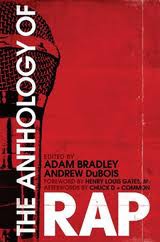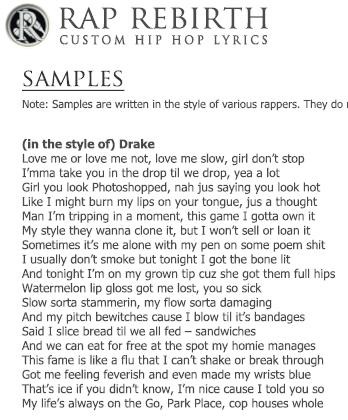Why We Shouldn't Treat Rap As Poetry
by Willy Staley

Jesse Kramer is a 24-year-old freelance writer, of sorts, but one whose talents are actually in demand. Right out of USC, with a major in Business, Kramer started a business called Rap Rebirth. It’s a one-stop shop for all your rap needs. Jesse will help you punch up your rhymes, hooks, metaphors and similes; he’ll write you anything from a 16-bar verse to a whole album. He can even make you sound like Drake, if you want (odds are you will, apparently), and his business just might pose a problem to academics who want to make a name off of treating rap as something it is not.
In academia, elevating a “low art” to the status of high art can get a young scholar a good deal of attention. Late last year Yale Press released the Yale Anthology of Rap, to both fanfare and criticism. The book is an excellent example of how much attention high-low-brow academic efforts can draw. Slate ran a three-part series on the transcription errors in the volume, with writer Paul Devlin eventually visiting Grandmaster Caz at his house in the Bronx to go over the various errors made by editors Adam Bradley and Andrew DuBois while transcribing a low-quality recording of Caz’s “Live at Harlem World 1981.”
What Devlin doesn’t mention is that Grandmaster Caz’s words appear elsewhere in the anthology, credited to Big Bank Hank of the Sugarhill Gang, in “Rapper’s Delight.” “Rapper’s Delight” was the first rap song to go mainstream, and its second verse was not written by the person performing it. Furthermore, Caz was not a willing collaborator in “Rapper’s Delight”; his words were stolen and he never made a nickel off the song. This sort of thing can be impossible to prove one way or another, but, in this case, an astute listener can pick it out — it’s all pretty clear if you know who’s who. Right at the top of the verse, Big Bank Hank declares “I’m the C-A-S-A-N-O-V-A and the rest is F-L-Y”; Casanova Fly was Grandmaster Caz’s other name, aside from the one on his birth certificate. In the same song, Hank also claims that he’s 6′ 1″, though video evidence suggests Big Bank Hank has a more George Costanza-esque frame than that line would suggest. In a later verse, Hank boasts that he’s “the grandmaster with the three MCs”; Sugarhill Gang only had three MC’s; The Cold Crush Brothers, Caz’s group, had four (actually the size varied, but let’s not get bogged down in details).
DuBois and Bradley mention this debate in passing in the intro to “Rappers Delight” in the form of a question — “Did Big Bank Hank, who was discovered by [Sylvia] Robinson rapping while working at a pizzeria, steal his rhymes from the rhyme book of his acquaintance Grandmaster Caz?” — when everyone else familiar with the story seems to agree that Caz’s account is factual. So while Devlin’s critiques were fascinating, valid and clearly time consuming (the Bronx!?), I think he missed the opportunity to level an even bigger critique of the Anthology. Namely, that its premise — that rap lyrics, separated from their performative context, can be read as literature or poetry, or both — is faulty. Very faulty.

Caz isn’t the only uncredited “poet” in the anthology. Eazy-E gets credit for his verses on “Gangsta, Gangsta” and “Dopeman (Remix)”, both off of NWA’s seminal album, Straight Outta Compton. It’s a good thing they left “8 Ball” out of the anthology. Maybe they thought it wasn’t as good as the others (I’d have bumped either for “8 Ball” in a heartbeat, but I’m a white dude from California like that) but maybe it was also because the song contains the line, rapped by Eazy, “Ice Cube writes the rhymes that I say.” Eazy had no problem admitting it — we now know that he was more of a financier of the group than a creative mind — but acknowledging it might have necessitated some academic gymnastics on the part of DuBois and Bradley, that they’d rather avoid. It’s hard to make a convincing case for rap as poetry if you can never credit authors properly.
Now, this is not to say that DuBois and Bradley don’t deal with this problem. In their attempt to anthologize Rap As Poetry (an impulse we will heretofore abbreviate as RAP), they explain that they want to focus on the technical aspects of the poetry, not the performative ones, so the issue of authorship is made irrelevant. Watch as they explain it away:
Ghostwriting, the practice of one artists supplying lyrics for another to perform, has been around since rap’s beginnings. However, given the audience’s expectation that rappers’ words should be their own, it has almost always been transacted behind the scenes. Rap lyrics are so closely associated with the identity of the artist that the idea of a distinction between writer and performer seems counterintuitive. Nonetheless, rap is in its essence, a collaborative art form, from the tapestry of its densely layered samples to its borrowed lyrical riffs and reverences. For the purposes of this anthology, we have elected to include all lyrics under the names of the their performers. We do this for both practical and aesthetic reasons. Practically, we recognize the impossibility of discerning with absolute certainty which artists wrote their own lyrics and which did not. Aesthetically, we believe that the act of performance constitutes a kind of composition; though the Beastie Boys, for instance, did not compose all the verses on “Paul Revere,” their distinctive voices and deliveries shape the song and remain in our memory, even when the lyrics are brought back on the page.
As a rule, however, this anthology emphasizes poetry over performance. This is not, after all, a collection of lyrics from rap’s greatest hits, but rather a collection of rap’s best poetry.
Ah, yes. See how important rap’s performative aspects become when you must rise to defend RAP from the realities of rap? But RAP, as the editors explain, “stimulates greater appreciation for rap music than one might otherwise gain from listening to the recordings alone.” So, rap as performance (which we will not abbreviate as RAP) is only important to RAP when it is convenient for side-stepping the ghostwriting problem.
Not only can stripping rap of its performative context make authorship a complex issue, it’s a bit reductive, and it makes it difficult to tell who is good at rap and who is bad at rap, as this story in NPR demonstrates. It was essentially a rap version of the classic cognitive science thought experiment about the existence of qualia, Mary the Color Scientist. (In the experiment, Mary is confined to a world that is completely black and white, but she studies our visual neurological pathways, and how we experience color. In essence, she knows everything there is to know about color, but she has never seen one. When she finally goes outside to the real world, will she learn anything new about color?) Sam Anderson, New York’s literary critic, has somehow never listened to rap, but he reviewed the Anthology as if it were any other volume of poetry. NPR thought of the bright idea to catch up with him, and force him to listen to the stuff — apparently, he had yet to succumb to curiosity — to entertaining results.
We learn that, to the uninitiated, Ol’ Dirty Bastard’s “Brooklyn Zoo” doesn’t look good on paper (makes one wonder how the second verse on “Shimmy Shimmy Ya” might look); Rakim, Big Daddy Kane, and other early greats look amazing by comparison. This seems obvious. You can’t hear the way Too $hort says the word — his word! — “bitch” on “Cusswords”, the scratches and snares on Schoolly D’s “PSK, What Does it Mean?”, or the aggression in the way Pimp C opens up UGK’s “Murder” — all songs in the Anthology that Anderson doesn’t even mention in his article, or NPR’s. So without even approaching the topic of authorship, the value of stripping rap lyrics of their musical and performative components is already questionable.
But authorship is clearly more important than DuBois and Bradley like to pretend, and it has only gotten harder to pin down since the days of “Rapper’s Delight.” Even though rap is an art form that has benefited greatly from the practice of sampling and borrowing on the production side, its lyrical claims to authenticity make authorship an important, maybe even central issue to the genre, one that cannot be explained away in 200 words. And here is where we get back to Jesse Kramer’s new business, Rap Rebirth, which is, in essence a one-man rap editorial agency.
I spoke Kramer on the phone, from Los Angeles, to get a sense of how his business works, and what that might mean for the enterprise of RAP — and, I suppose, rap.
Kramer’s business model is a bit of a departure from the way ghostwriting usually happens. Typically, rappers write verses for one another. Sometimes this is done peaceably. You might see N. Jones listed in the liner notes to songs Nas didn’t appear on. Other times, business is not conducted in a straightforward fashion, leading to inevitable he-said-he-said situations. Philadelphia rapper Gillie the Kid seems to want to take credit for Lil Wayne’s whole catalog. Incarcerated rapper Max B claimed to have written Jim Jones’s “We Fly High,” and furthermore said that he thought it sucked. The rapper [Mad] Skillz has been known to air out those for whom he has offered his services. Rappers writing for other rappers can get messy, especially when ghostwritten lyrics typically go upstream, so to speak — less-famous rappers ghostwriting for their more famous, but less talented, or otherwise creatively exhausted, counterparts.
Not Rap Rebirth, though, and Kramer recognizes that that’s an asset. “I’m not trying to sell records,” he tells me. “So I’m not interested in grabbing fame off of someone else’s name. And I understand that confidentiality is so important to so many artists. So to keep that confidentiality maintains my reputation and generates more business for me. I align my interests with the artists’ a little bit more than, say, a rapper who’s writing for another rapper.”
So how does Rap Rebirth work?

Rappers come to the site on their own — it doesn’t hurt that Rap Rebirth is the number one Google hit for “rap ghostwriting” — and he gets a good amount word-of-mouth referrals. What happens next, in his words, is his new client will “tell me about themselves. They tell me about formative experiences, what it was like growing up, milestones in their life. They tell me where they’re from. They tell me about their family and their friends, their crew. They tell me about slang in their neighborhood, their interests, who their artistic influences are.” That last part, totally unironically. And then, when everything is squared away, for just $25, Jesse writes them a 16-bar sample verse, as if he were them. “It’s a low-risk way for them to decide whether [we’re] a good fit,” he explains.
From there, Kramer and his client figure out if and how they want to collaborate. His work ranges in scope from punching up individual rhymes, to writing whole albums. He has lots of regular clients as well as one-off clients. For some of his regulars, Kramer estimates he has written 90 percent of their material. For others, maybe a little less than half.
He breaks down his clientele this way: about 60 percent up-and-coming artists, recording their first or second mixtape; 20 percent underground acts who have been around for longer; and about 20 percent “more established” artists. He clarifies on that last bit, “I don’t want to say mainstream, but they have more to work with.” Approximately 60 percent of his clientele is black, 20 percent are white, 10 percent are Latino, and 10 percent are Asian. This is a pretty accurate breakdown of California rap’s demographics, but Rap Rebirth’s clients also come from faraway lands — including one from West Africa.
Kramer estimates that roughly one quarter of his clientele — specifically, 40 percent of the 60 percent of the up-and-coming artists he writes for — request that he makes them sound like Drake. About half request that he give them a more “gangsta” image. I asked him if he found it difficult, or funny, writing fake stories about a drug underworld that neither he nor his clients (apparently) know all that much about. He told me it was weird initially but that he has been “listening to hip-hop for so long, you know, it doesn’t even seem strange.” Anyone who listens to enough rap knows that feeling well. What Kramer considers more ironic is the backpack rappers he writes for, who frequently ask him to write raps for them about how good they are about writing raps.
What is fascinating about Kramer’s talent for writing rap lyrics is how closely it parallels Yale’s strictly textual approach to rap. Except for when a client requests a “reference track” — that is, Kramer rapping his words as he meant for them to be rapped, should the text alone not make this clear enough — he doesn’t really rap. “I mean, I like going to karaoke with my buddies and doing some LL or something, but that’s about it,” he tells me.
Kramer started writing raps when he was about 14, a couple years after he really got into listening to rap. Inspired by his favorites, like Rakim, A Tribe Called Quest, Mobb Deep, Wu Tang, and Nas, he turned to the digial pen-and-pad: internet message boards. There, he would post verses, get into faux-freestyle battles, and practice his craft, all in text. And that’s how he would be evaluated, on the words alone. “I mean initially, you know, [the response was] not so good,” Kramer says, but “I got better and better and better and by the end I was getting real good response.” This seems strange, to become a better rapper in other people’s heads without ever really having to rap, but then again, for the rest of us who write, when was the last time you read — or rapped! — aloud something you wrote?
Kramer’s talent for writing rhymes, at a glance, might seem to reinforce the legitimacy of Rap As Poetry, and only poses problems for rap as primary document. He has, after all, bettered his craft in a strictly textual setting, and this skill is transferable to performative context, as evidenced by the fact that dozens of artists pay him for his work. I asked Kramer what he thinks of RAP, and he is all for it. “Good rap is definitely poetry,” he says, “and it’s up there with the best poetry.” But he makes an important distinction, that seems like a necessary one for someone in his position, “you have to be careful, because it’s also a product, and it’s also entertainment. It’s not purely art.” But then again, what is?
Where Rap Rebirth starts to provide problems for RAP is not easy to pinpoint, in part because RAP is conceptually loose. As Kramer, along with DuBois and Bradley, points out, only some rap is really poetry — specifically the raps that are poetic, or important for other historical reasons. And that’s where RAP gets into trouble. The study of RAP purports to not care about the lyrical content, and only the lyrical form, but based on what is included in the anthology, it is clear that that couldn’t possibly be true.
Rap is entirely inseparable from its lyrical content, and its lyrics are inseparable from their insecure claims to authenticity, and inevitable descent into exaggeration and self-aggrandizing. The constant use of the first person and the notion that rap is “street reportage” makes ghostwriting a problem for RAP, because the Yale Anthology cares more about the content and primary document aspects of rap than the editors care to admit. Isolating the lyrics from both the music, the performance, and the author makes them utterly uninteresting as art, and DuBois and Bradley know that. But it does provide a means for them to treat rap as poetry, and that’s what they want to do. Because you can make books of poetry, and you can’t make books of rap.
Rap is so many things to so many different people. But at its core, it is made up of rhyming verse. But just because Dr. Dre and Dr. Seuss both use the same medium Shakespeare used to tell stories, it doesn’t necessarily follow that either of them are poets. Consider this proposition in reverse to see how absurd it is: For my graduate thesis, I am going to give Calvin Trillin a bunch of half-assed instrumentals and have DJ Drama help him put together a Gangta Grillz mixtape, and then we’ll evaluate him alongside Gucci Mane and Cam’ron, and other rappers who have made Gangsta Grillz mixtapes. That would be awesome, but it would not provide any more insight into the how and why Calvin Trillin does what he does. It would simply provide me the opportunity to take someone else’s work, put it in a different context, and call it something different.
Treating rap as poetry explains away too much of the sloppy realities about how and why it happens. We should just go back to treating rap as rap. It’s far more enjoyable to embrace the mess.
Willy Staley, believe it or not, has a Tumblr.
